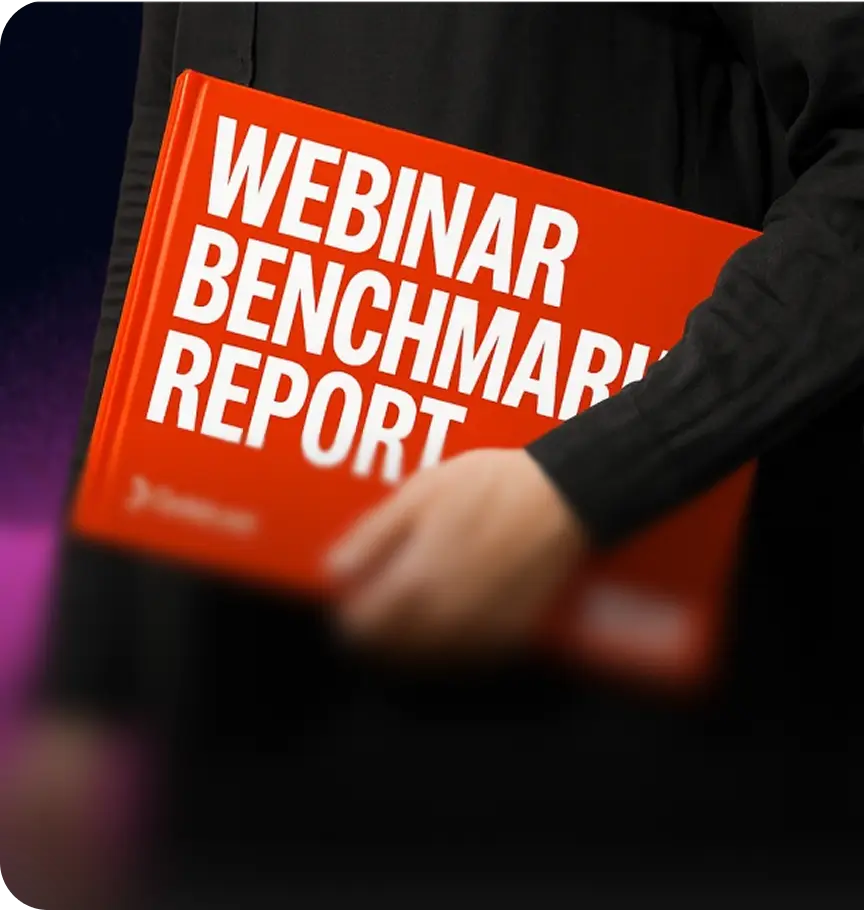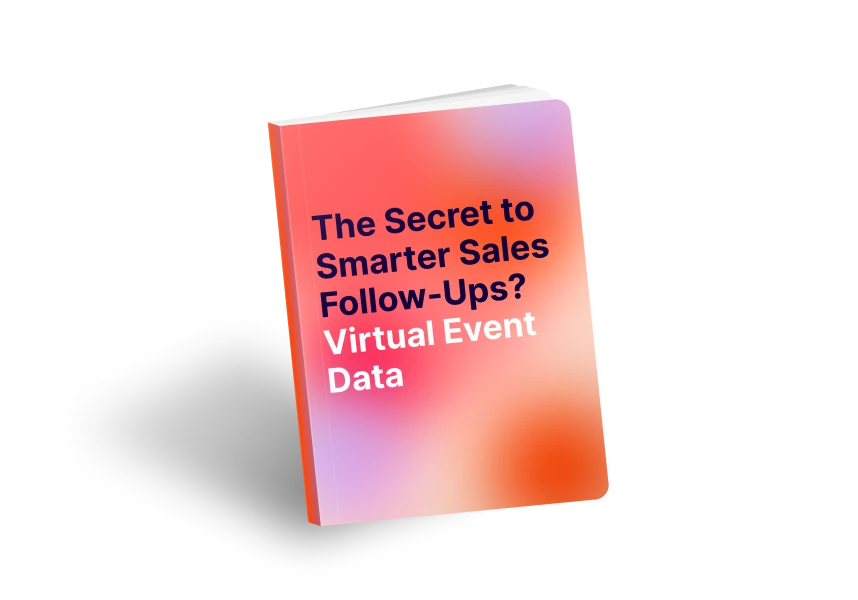The Secret to Smarter Sales Follow-Ups? Virtual Event Data
In this action-packed eBook, we share the steps you need to take to transform virtual events into revenue, starting with better post-event sales follow-ups.
Sales and marketing—name a better duo. We’ll wait.
These two teams go together like peanut butter and jelly. And while they may have a history of competing for attribution, we’re declaring this the year of sales and marketing alignment.
A recent Gartner study revealed B2B buyers say they prefer a rep-free experience—but those who buy through digital channels alone are more likely to regret their purchase.
Sales and marketing must work seamlessly together. Here are just a few of the reasons why:
- Organizations with unified commercial strategies see 50% higher revenue growth than their competitors.
- Integrating sales, marketing, and service increased year-over-year revenue by 48% in one Gartner case study.
- How and when reps intervene in the sales process is key to buyer confidence and better deals.
The bottom line is, well, your bottom line: Revenue. More than other teams, sales and marketing have a measurable, frontline impact on ROI.
As a revenue-driven event marketer, sales needs you to set them up for a slam dunk—and you need sales to sink it.
So how can you set your counterparts up for success? By arming them with quality insights. We’re talking juicy, relevant data straight from the source. Data that will help them connect in the right ways at the right times to close more deals.
Step 1. Initiate a goal-centered conversation
Let’s say you’ve got a virtual event on the horizon.
Sure, you might have a clear registration goal, but most companies don’t spend hours creating a stellar event with attendance as the end-goal.
Depending on your event, you might also be (at least partially) responsible for goals like:
- Event engagement
- Pipeline generated
- Deals closed-won
Event marketers typically need 4-6 weeks of promotion time pre-event. So way, way before your event, it’s time to engage sales in a conversation about goals.
Your initial discussion should focus on setting clear, sales-led goals. To get into the right headspace, go into the meeting with the bigger picture in mind. Consider asking: What revenue-friendly event data can we provide to the sales team?
“When two teams respect each other and respect each other's work, I think that's when you have the most success. Anna Suslova, Director of Global Marketing Programs at Axonius
It’s not as simple as asking, “How can I help?” Anna regularly checks in with sales to ask, “How can we help you be more successful as a sales director or rep?”
Avoid ambiguity by asking the right questions:
- What are the exact metrics that will define event success for you?
- How will you measure your success in moving deals forward post-event?
- Exactly how many closed-won opportunities are you aiming for?
Your job is to get sales to see that this event is worth their time and attention. Get them excited about all the ways event data can help them hit their targets and bring in revenue.
“We look at pipeline from a first-touch, last-touch, and an in-between touch—pipeline that’s influenced, created, or converted to demo by our campaigns.” Candace Gregg, senior director, global demand generation at Bloomreach
Step 2. Use the right KPIs to track your event goals
The definition of event success differs for everyone. Ask sales to clarify which KPIs will best measure event success for them.
For the sake of keeping things focused, there are essentially three levels of virtual event KPIs you can offer.
Level 1: Baseline virtual event KPIs
- Registrations
- Attendance
- NPS
- ROI
Realistically, registration and attendance data doesn’t help the sales team all that much. They need details about which opportunities will be waiting in the pipeline post-event.
So let’s up our game a bit.
Level 2: Deep engagement insights
- Most viewed sessions
- Time spent in breakout rooms
- Geographical data
- Number of chat messages
- Cohort data
- Who did companies send? Job titles?
- Which sessions did they attend?
Now you might see sales’ ears start to perk up. Deep engagement analytics can be an awesome tool for helping the sales team to personalize their follow-ups and increase their total number of relevant engagements, and ultimately their win rate.
Of course, if you really want to win them over, you’ll have to prove a real connection between your event and their bottom line.
Which brings us to the next level of event KPIs.
Level 3: Sales-led event KPIs
- Net new leads
- How many attended?
- How many were qualified as MQLs?
- What did they interact with? How long?
- Number of touch points/influenced pipeline
- Account level insights
- How long did each account spend in breakout rooms?
- How many sessions did each account attend?
- Which sessions did they attend?
- What content did they download?
- How many polls did they answer (and how did they answer)?
- How many questions did they ask (and what were they)?
- Lead progression velocity
- Closed-won opportunities
Pre-event smarketing masterclass with Terminus 💡
ABM marketing platform Terminus understands the impact working with sales before the event. Opening a dialogue with sales from the get-go allowed the Terminus marketing team to:
- Identify their event’s audience: 300 closed-lost opportunities, and goal: to generate new pipeline for Q1.
- Categorize accounts from previous interactions and serve ads and email signature banners to these accounts with relevant themes.
- Select key contacts from each account to send a direct mail bundle.
Step 3. Involve sales in your event
It might sound obvious, but if your sales reps are sitting around waiting for you to hand off the MQLs from your latest event—your alignment could use some work.
The sales team are the experts in talking to your prospects. Why not use their firsthand experience and insights to create event content that will help accelerate the pipeline?
Your virtual event platform makes all the difference here. To help bring sales in closer—and make your follow-ups more relevant—choose a platform with robust engagement tools that allow reps to engage customers via:
- Chat features
- Live video and pitch-free demos
- Exclusive 1:1s and roundtables
Bringing your sales reps into the event can jumpstart your attendee’s journey from prospect to happy customer.
Step 4. Give sales the data they want
At this point, you’re well on your way to effective, data-driven follow-ups. But your smarketing work isn’t done yet.
You need to hand over relevant and insightful data that’s on the money (and generates some too 💰).
If you’re using a robust event platform, you likely have a plethora of data on attendee behavior. But when you’re packaging it up for sales, it’s crucial to focus on the data needed to meet their goals.
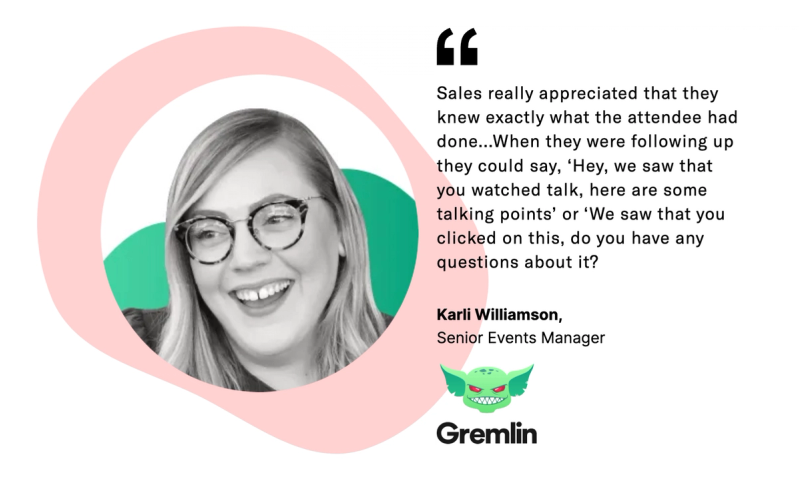
The more insights you have on every account in your pipeline, the more specific and need-meeting their conversations become.
This deeply personalized sales approach empowers your reps to:
- Build stronger relationships
- Handle objections quickly
- Assess needs and deliver support
- Achieve greater close rates (about 50% more than traditional sales)
- Engage top accounts to reduce customer churn
Pretty impressive benefits—all from collecting insightful event data and applying it to your sales follow-ups.
Step 5. Nail the post-event handoff
Congrats! You launched another amazing event. Time to kick back and watch the revenue flow in, right? Not quite.
The post-event handoff is a vital part of your data-led event strategy. Here are three tips to nail it.
Make your event data easy to digest
Your sales team already has their own ever-growing to-do list. And wrapping their heads around your massive spreadsheet export probably isn’t on it.
Skip the data dump and opt for a seamless integration to get all the right insights straight into your CRM. No spreadsheets. No manual data wrangling. 💯
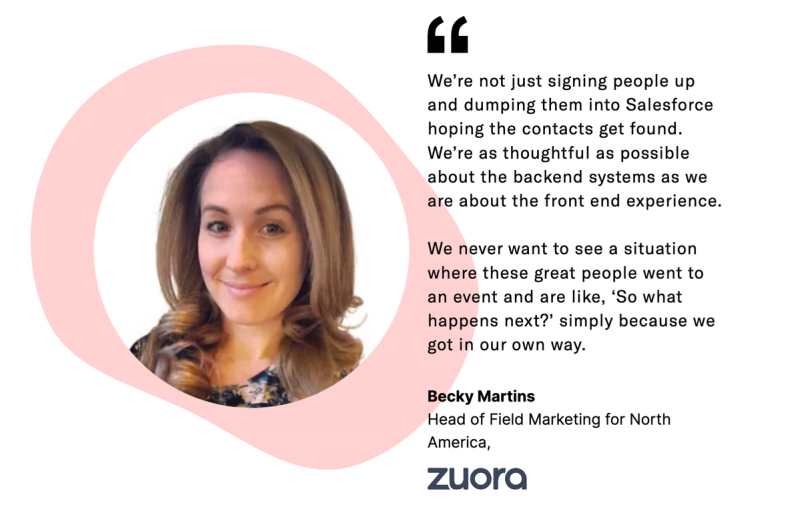
You can even give your sales team direct access to your event platform’s insight dashboard where they can access all attendee-level data in one place.
“The Marketo integration helps with our lead flow process. If our customers or prospects attend events, the integration makes sure all that information is pushed back to Marketo which in turn pushes it back into our CRM, Salesforce. It’s really efficient.” Laura Wille, Director of Growth Marketing at Clari
Segment your attendees for personalized follow-up
When it comes to follow-up, a boilerplate “thank you for coming” email isn’t enough to transition attendees into focused conversations with sales.
But by segmenting attendees based on how they engaged with your event, you can customize your follow-up messages and empower sales to do the same.
Let’s revisit our friends at Axonius. After their big event, Anna and her team used Goldcast’s integration with Hubspot to push qualified prospects straight to their CRM.
They divided prospects into three segments:
- No shows received a recording of the event, some content and a CTA.
- Attendees received an exclusive report, some company news, and a demo link.
- Demo attendees received a short thank you, an on-demand recording of the event, and a reminder that the team is available for questions.
The sales team went to work reaching out to the latter two segments, using separate templates for each and personalizing first touches.

Launch data-driven nurture campaigns
It’s impossible to overemphasize the importance of personalization in sales follow-ups. And meaningful personalization requires meaningful data.
Go the extra mile for your pals in sales by providing super compelling account-level insights, like:
- Clicks
- Polls answered
- Breakout rooms entered
- Sessions attended
- Booths visited
- Videos viewed
- Content downloaded
Axonius funnels every event attendee who doesn’t convert into a personalized nurture campaign until they’re ready to engage.
Here’s the trick to nurture campaigns: Whichever post-webinar email sequence your prospect is destined for, it’s crucial to get your first touch out fast. Otherwise, you’ll lose the engagement and momentum from your event.
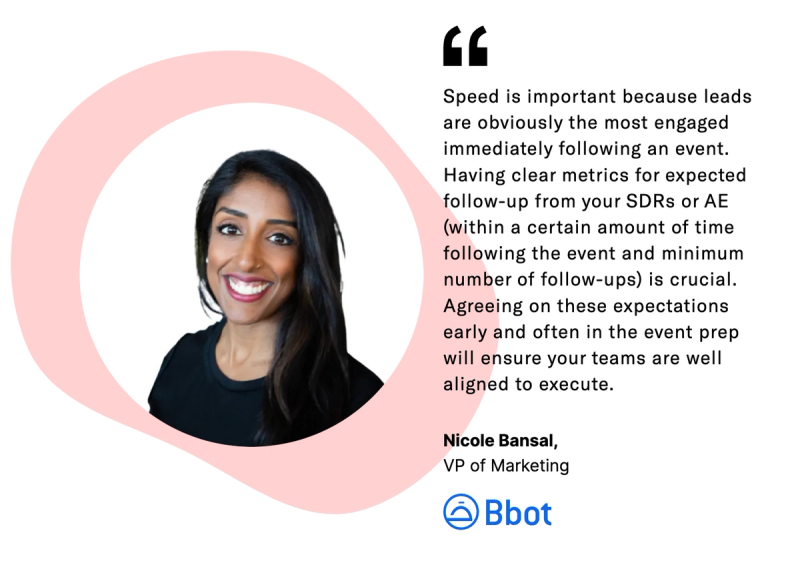
By collaborating with sales to create curated campaigns based on engagement levels, you can extend your prospects’ brand experience and accelerate their journey through the pipeline.
“Our teams can look at a report and come armed to the conversation with, ‘Hey, I saw you engaged in this way.’” Hayley Ferrante, Director of Digital Programs at Zuora
Empower your sales reps to stand out in the crowd
There’s a lot of noise out there for B2B buyers. But with the right event data at your fingertips, you can give your prospects a five-star brand experience from registration to closed-won.
📌 Remember:
- It all starts with an early conversation with sales about goals.
- Focus on KPIs that are hyper relevant to the goals you share with sales.
- Engage the sales team in your event to get the right conversations rolling.
- Nail the post-event data handoff by presenting insights in a way that makes it easy for sales to act.
“Goldcast is in the 21st century. They’re on the leading edge of what marketers want. They want customization. They want the ability to interact with attendees in a meaningful way. And as an event organizer, they want it to be easy.” Katie Dunn, Senior Demand Generation Manager at ThoughtSpot
With Goldcast on your side, you can gently guide your prospects through the funnel by
- Executing well-curated event experiences
- Creating opportunities for meaningful interactions
- Generating provable ROI at every stage of the journey
Now that’s what we call sales and marketing alignment. 🤝
Ready to impress sales and wow your prospects?
Goldcast gives you the digital event data you need to help make it happen.
Stay In Touch
Platform
Resources
© 2025 Copyright Goldcast, Inc. All rights reserved.



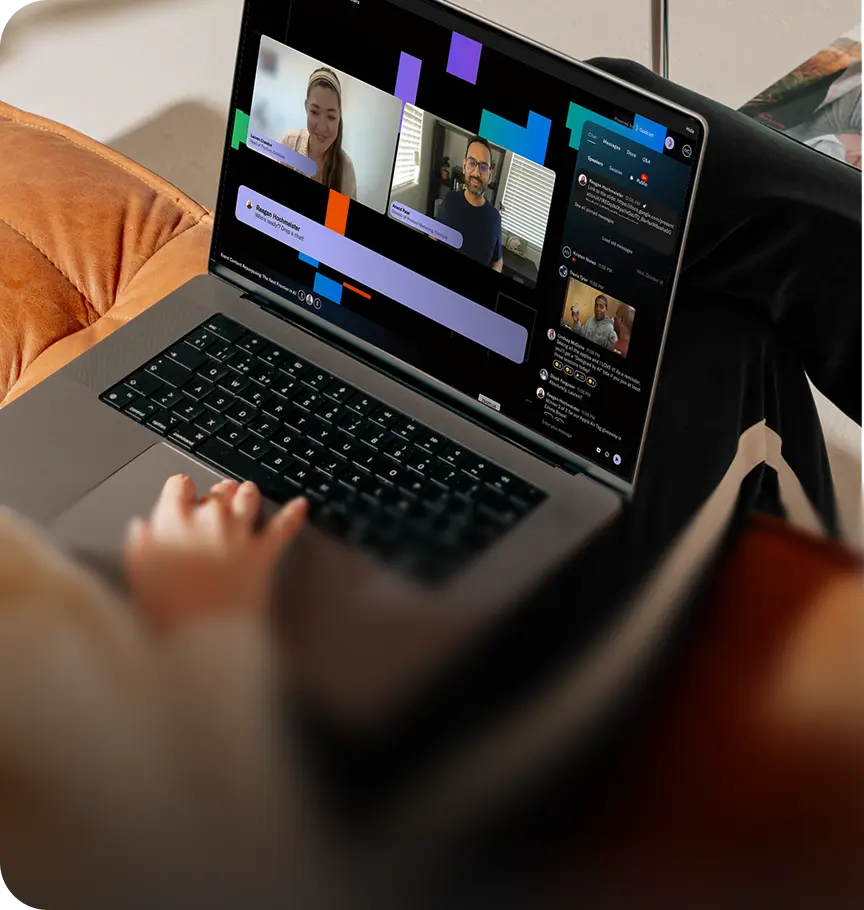

 Upcoming Events
Upcoming Events Event Series
Event Series On-Demand Events
On-Demand Events